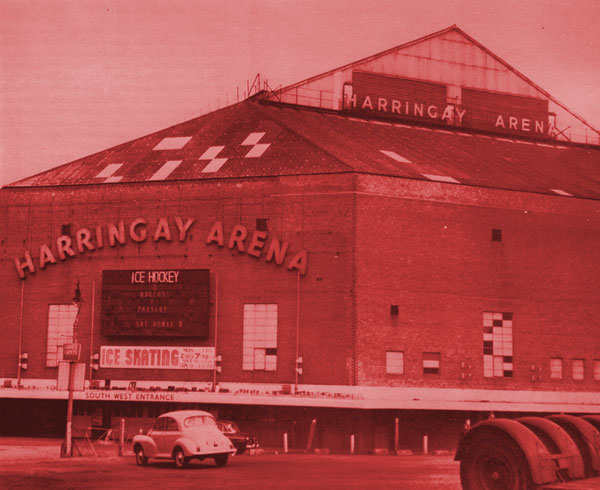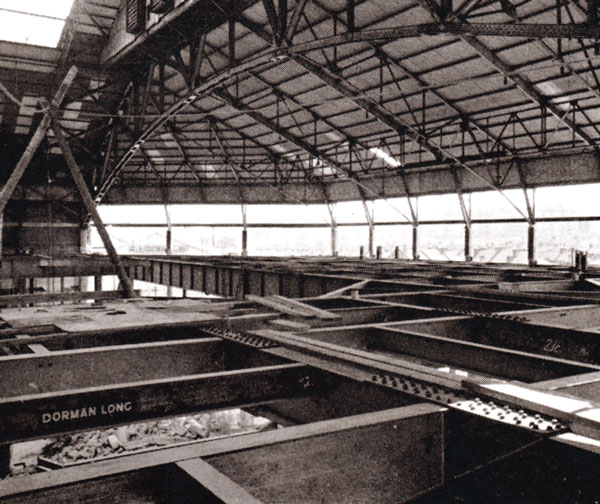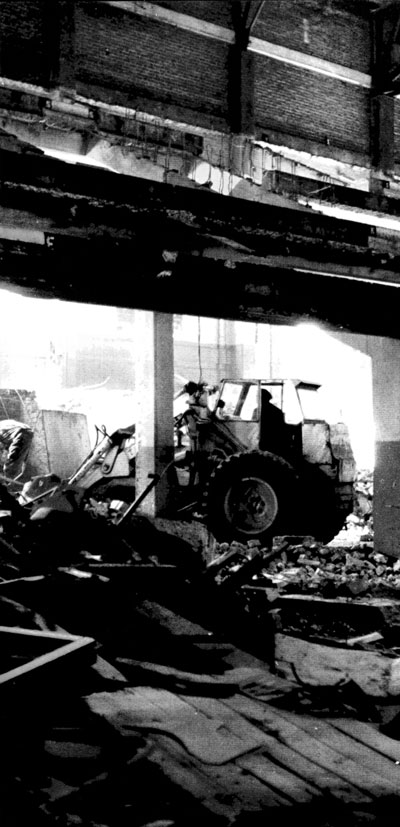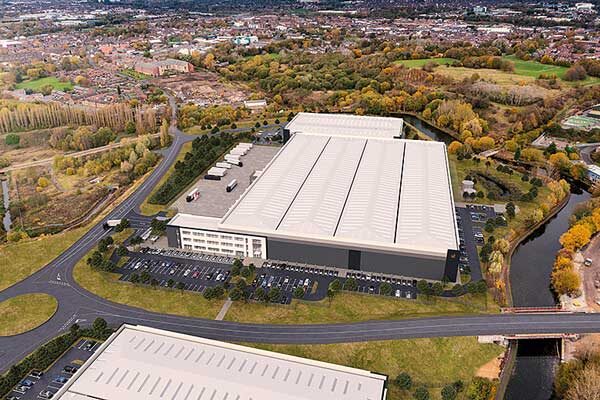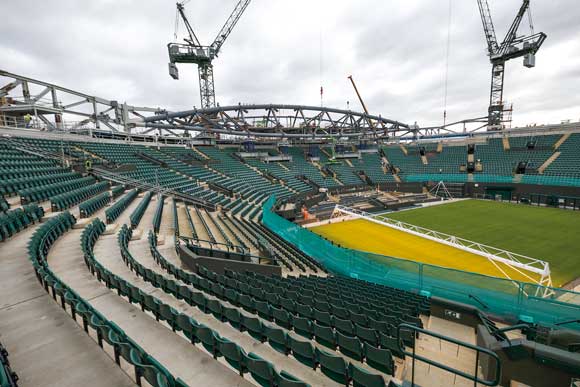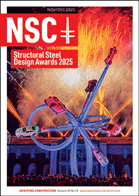50 & 20 Years Ago
An example of Steel’s flexibility – Harringay Arena
BY FREDERICK S. SNOW, C.B.E., M.I.C.E., M.I.Mech.E., P.P.I.Struct.E., M.Cons.E.
From Building with Steel August 1960
In the years before and after the Second World War, Harringay Arena was a name intimately associated with a wide variety of sports, in particular, ice hockey and boxing. It therefore came as a considerable surprise to the sporting public when it was announced that the Arena and the adjoining Market Hall were to be sold by the Greyhound Racing Association to Allied Suppliers Limited, for use as a depot for the warehousing and distribution of domestic consumer goods.
The decision to adapt the Arena, so that it could be used for a purpose entirely different from that for which it had originally been designed, was an unprecedented step which could not have been contemplated had the original building been of other than steel construction.
THE ORIGINAL ARENA
The original purpose of the building was to provide a sports arena and the problem then was to provide a large roof area and at the same time to give all the spectators an uninterrupted view of the arena. This necessitated tiered seats and the sloping supports for these seats were an integral part of the design to achieve structural stability of the huge roof which had a clear span of 223 ft. The roof was carried on five trusses at 51-ft. centres rising from a springing height of 35 ft. to a ridge height of 100 ft. The size of these trusses was such that it proved economic to build them in high tensile steel and the roof was, in fact, one of the earliest examples of the use of high tensile steel in this form of construction and is believed to be the largest example of its kind.
The present problem was to convert this special purpose building with its functional design to an entirely different use and this required the removal of the tiered support of the roof and its replacement by a gallery which, while providing additional floor space, fulfilled all the functional requirements of the original supports.
PLANS AND PROBLEMS
In the early stages of planning, it was obvious that it would be desirable to remove the rakers, but it would be vital to replace them with an alternative structure to provide restraint to the external stanchions at a similar level. The solution was found in the decision to construct a gallery floor at this level, which, by providing office and further storage space would help to take full advantage of the enormous volume of the building.
The dismantling of the existing steelwork reduced the stability of the building shell but this was readily compensated for by the steel framework which replaced it and which was admirable for the purpose.
The walls and stanchions of the existing building are supported on piled foundations, and the Piccadilly Line tube tunnels run diagonally under the building. In order to bridge the tunnels, part of the superstructure is supported on large beams. The centre portion of the Arena, containing the old ice rink floor, is free of any piling and the new gallery floor was to be made in the form of an annular rectangle 50 ft. wide, so that as much as possible of the existing foundations could be utilized. The 210 ft. by 50 ft. framing adopted for each long side, was essentially a space grid with freely supported edge conditions. Portal frames designed with fixed ends were introduced at 5 I ft. 6 in. centres, which, through pin-jointed struts, provided adequate lateral restraint to the existing stanchions. The entire floor framing constituted a form of horizontal bracing to ensure a sufficient margin of stability against overturning of the structure as a whole. These lateral loads together with the vertical loadings from the gallery were ultimately transmitted to the foundations through these portals. Although the sections used for this area were 36 in. by 16½ in. by 230 lb. and 36 in. by 12 in. by 170 lb. universal beams, i.e. the largest of the rolled beam sections, the design proved more economical than a conventional ‘simple design’.
High strength, friction-grip bolting was adopted at major structural connections, e.g. at splices in continuous plate girders, node points of the space grids where there was continuity in two directions, and portal frame knuckles. The largest size bolts used were 1 in. diameter. This helped in achieving neater details, speedier and more economic erection, and more dependable joint performance. Furthermore, any site welding was avoided.
Although a considerable amount of foundation work was necessary, it was possible to utilize a number of the existing pile-caps of which many were only 1 ft. 2 in. below the floor level. To avoid excessive cutting away, or alternatively a projection above floor level, the slab bases of the stanchions were designed to transmit the fixing moments, with ¾-in. fillet welds to the flanges and 5/16 in. for the web. In some cases the existing concrete was drilled with a rock drill and Rawlbolts used for holding down. In another case, a pin base could only be provided where the stanchion was supported on one of the existing large concrete beams, but fortunately it could be incorporated in a five-bay portal across the complete building, where the fixing moments could be taken up in the bases of the other three stanchion.
Four-hour fire resistance was required and the stanchions were cased in concrete for the full height. The floor beams, however, were cased with exfoliated vermiculite slabs. This method saved a great deal of dead weight and also allowed the gallery floor to be decked out with precast slabs ahead of the fireproofing.
The important feature of vermiculite lightweight encasures is that they are fixed by an adhesive. In the case of the secondary members hollow encasures were applied but for the larger members the use of the adhesive permitted the vermiculite slabs to be applied so that they followed the contour of the steelwork.
THE GARAGE
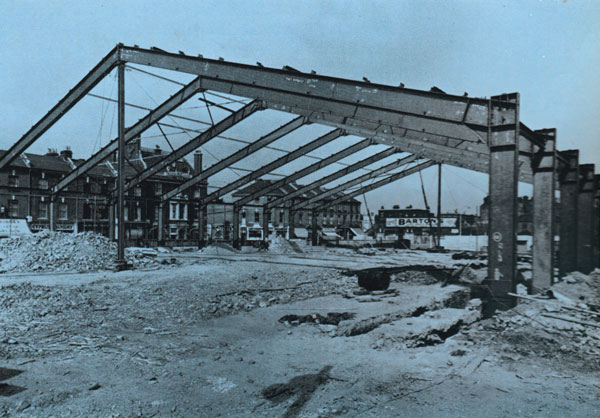
The overall scheme at Harringay called for the construction of a garage for a fleet of diesel lorries on the site of the old Market Hall, which stood between the Arena and Green Lanes.
The original building had a network of roof trusses and stanchions which had been altered to suit various subsequent requirements. To make the site usable as a garage, it was planned that some existing walls should remain, and that within them, an independent three-pin portal structure on piled foundations should be erected. Frames spanning 121 ft. were provided at 17-ft. centres. Standard universal beams were used for these, each rafter having one full strength, shop butt weld, and the site connections were made at the knee and the apex with high-tensile steel bolts.
LOADING BAY
It was planned that the roadway between the Arena and the garage should be roofed over and overhead travelling cranes installed running the full length of the Arena, for the purpose of loading prepacked containers on to the vehicles.
Tied portal frames of 41-ft. span were used for this purpose, with one leg supported at eaves level on the garage portals. The other leg required a separate framework immediately adjacent to the west side of the Arena building. Two eight-ton travelling cranes are now carried by this structure.
TIME FACTORS
At the end of March 1959 it was stipulated that the depot should be ready for operation by 1 February 1960. At that time most of the design work and drawings were in an embryo stage. No detail work had been undertaken, and no General Contractor appointed. The first stage of demolition work was in progress, but for stability, all existing cased steelwork was being left in position.
In early April the same contractors who had erected the original steelwork at Harringay were invited to fabricate and erect the steelwork for the alterations. Commencement of piling for the Arena conversion was scheduled for 11 May and steelwork erection was to start on 22 June, and be completed by the end of July.
The number of piles involved for the Arena was 275, and these were of 40-ton capacity. The planned conversion programme meant that the steelwork contractors had virtually to follow the piling contractor round the building, taking down the existing framework a little at a time and erecting the new steelwork to stabilize the building as they proceeded. They in turn were followed by the precast flooring contractor, decking out as each bay was made available.
As soon as the main structure within the Arena was finished, and whilst steelwork was being completed for mezzanine floors and offices, the steelwork contractors moved to the garage and loading bay area which was scheduled for completion by the end of September.
Despite many unexpected difficulties, some 1,000 tons of steelwork were erected on time and the client was able to take over the entire premises on the date specified.
ACHIEVEMENT
The new Harringay Depot of Allied Suppliers Limited has in the old Arena building a ground floor area of 7,400 square yards, thus forming the biggest single unit of its kind in the country. A further 4,200 square yards of space is provided by the gallery. Planned and rebuilt for a very definite purpose, the depot will serve as a warehousing and distribution centre serving the requirements of nearly a thousand grocery and provision shops up and down the country.
The conversion of Harringay for its new purpose was a courageous and striking operation and the Directors of Allied Suppliers Ltd are to be congratulated on their vision. Completion of this task on time called for utmost enthusiasm and co-operation from all involved, and the success with which problems encountered were tackled and overcome is compelling evidence of the ability of steel construction to meet the demands of a modern and changing world. Indeed, only steel could have been successfully used in this operation.

